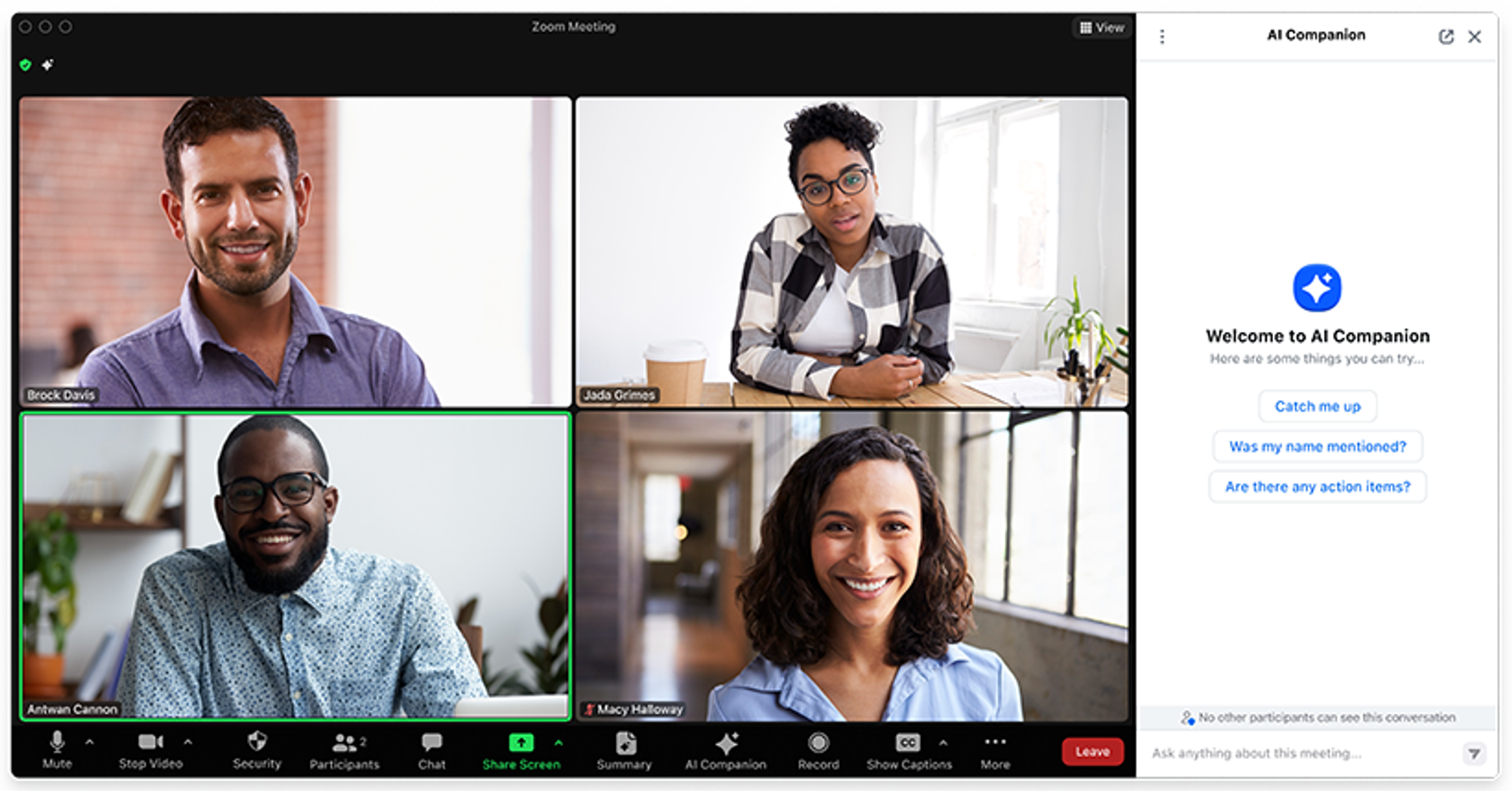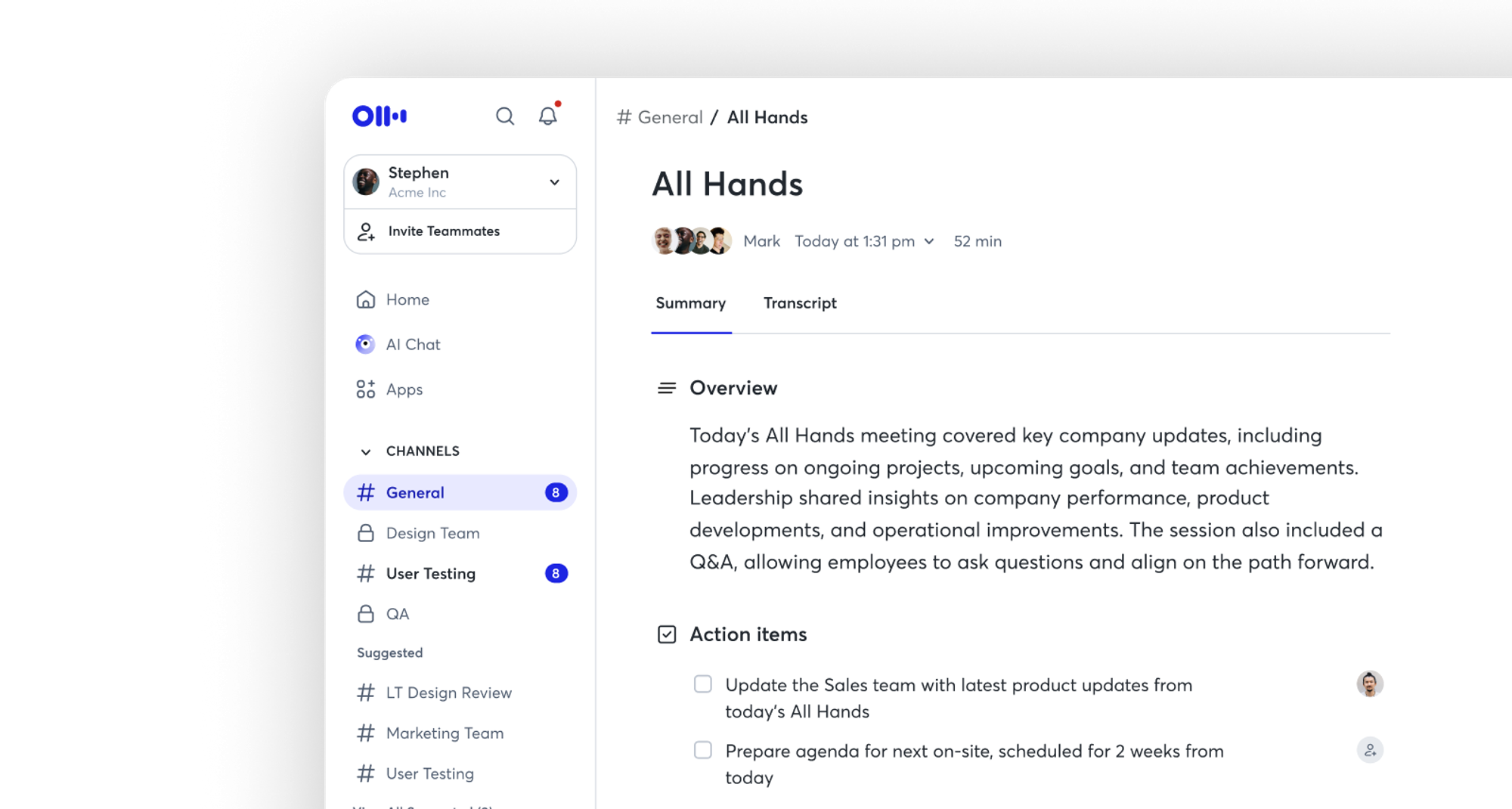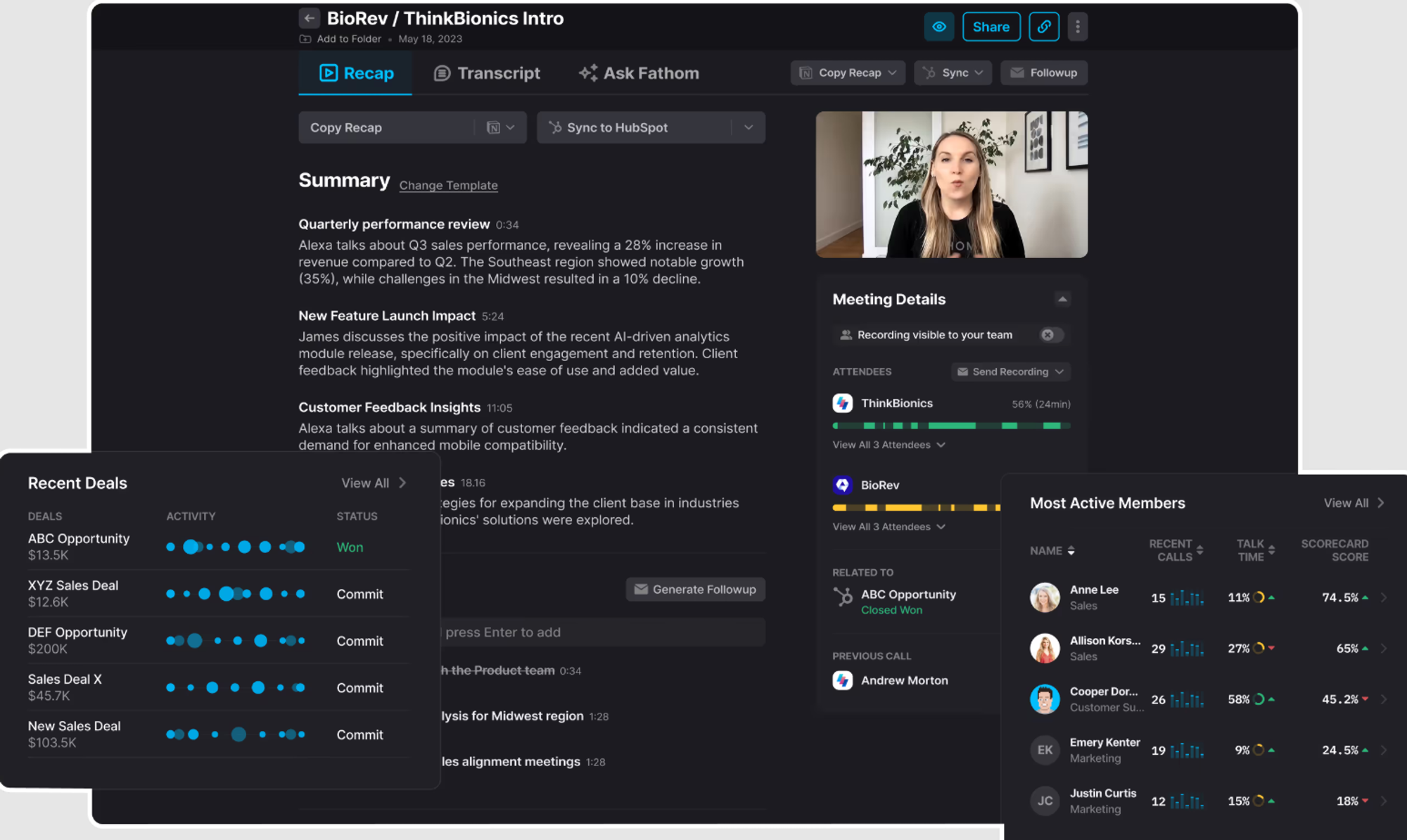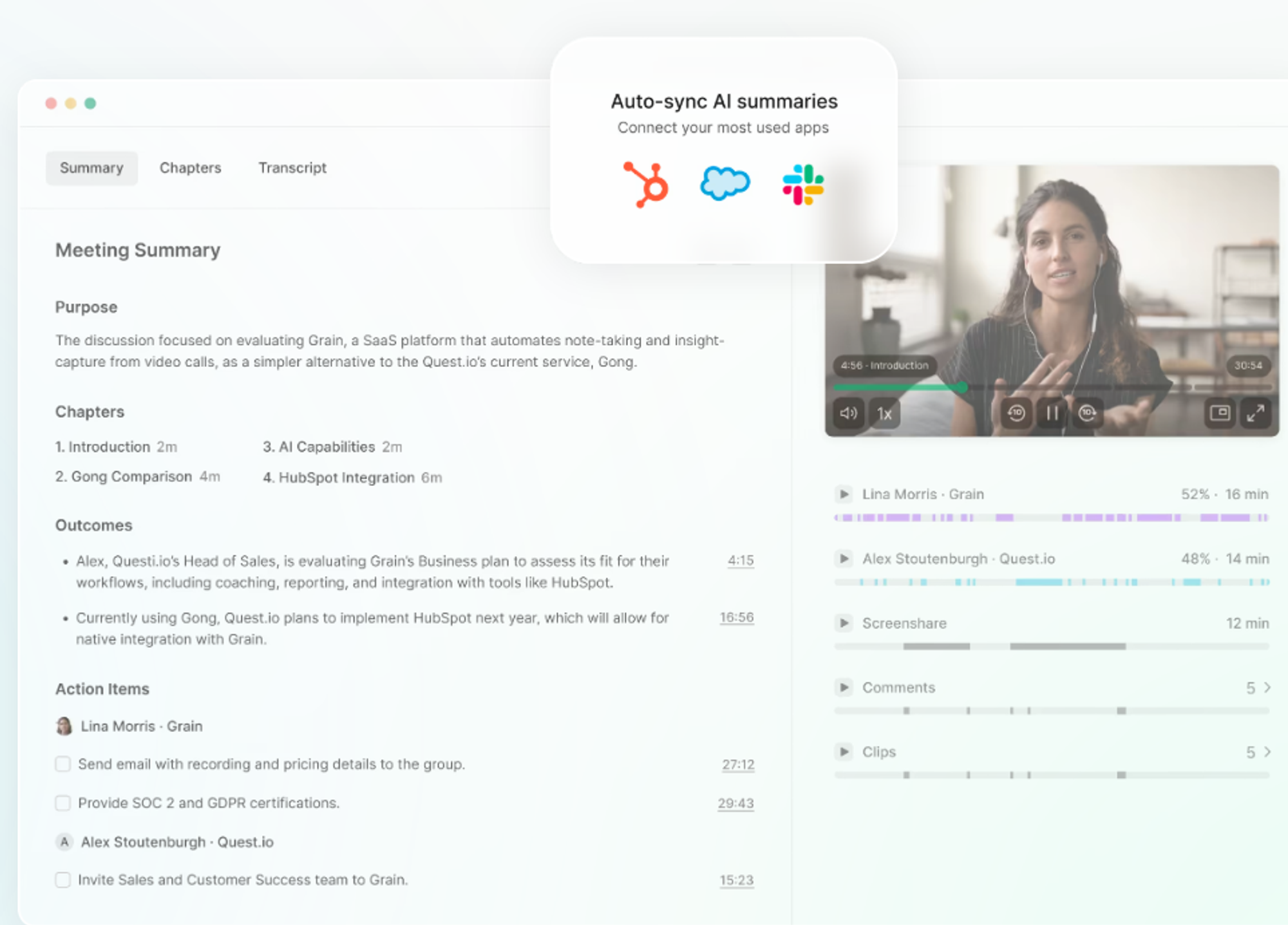The 7 best meeting recorders for founders (and why you might not need one)

When you’re closing deals, the last thing on your mind should be whether your meeting recorder captured everything.
Meeting recorders and notetakers are fantastic tools for eliminating that mental load. You can focus on what you do best, instead of hastily scribbling notes on scraps of paper you’ll end up losing anyway.
Here are some of the best meeting recorders and notetakers on the market (and a few reasons why you might be better off with a different tool).
7 of the best meeting recorders and notetakers
| Tool | Starting price | Free plan? | Best for | Main limitation |
| Zoom and Google Meet | Included in broader subscription | ✅ | Simple recording needs | Limited transcription and AI features |
| Fireflies.ai | $18/user/month | ✅ | Teams that want a separate library of recorded meetings | Limited integration with CRMs |
| Otter.ai | $16.99/user/month | ✅ | Teams that prioritize real-time transcription over business context | Primarily a transcription tool |
| Fathom | $20/user/month | ✅ | Budget-conscious teams | Large jump from the free plan to paid plans |
| tl;dv | $29/user/month | ✅ | Teams that reference visual content | Raw transcripts can require some cleaning |
| Grain | $19/user/month | ✅ | User research and UX studies | Limited outside user research use cases |
| Fellow | $11/user/month | ✅ | Collaborative note-taking | Project management features can overwhelm some users |
Zoom and Google Meet

What it does well
Most organizations start with the meeting recorders in their meeting tool of choice, usually Zoom or Google Meet. Built-in recording is simple, reliable, and doesn't require another tool. It just works and it’s always there when you need it.
The main limitation
Native meeting recordings give you raw video files and transcripts, but they don’t offer the AI analysis and broader business context of other platforms.
Best for
Quick, simple recordings that don’t need any additional features.
Fireflies.ai

What it does well
Fireflies pioneered the AI meeting assistant space and offers robust CRM integrations with HubSpot, Salesforce, and other platforms. It joins meetings automatically, generates accurate transcripts, and provides AI-powered conversation analytics.
The main limitation
Despite having CRM integrations, Fireflies still operates as a separate system. The integration typically just pushes a transcript to your CRM. From there, you might need to clean it or manually enrich contacts. Your Fireflies library becomes yet another place to search when you're trying to remember what a customer said.
Best for
Teams that need cross-platform meeting recordings and don't mind managing a separate meeting library.
Otter.ai

What it does well
Otter offers real-time transcription that appears as you speak, making it great for accessibility. It connects to calendar platforms and can automatically join scheduled meetings.
The main limitation
Otter is primarily a transcription tool, not a business intelligence tool. You get the transcript, but connecting that transcript to your deals, contacts, and revenue pipeline requires manual work or third-party automation tools.
Best for
Teams focused on accessibility and real-time transcription accuracy over business context.
Fathom

What it does well
Fathom’s free plan supports unlimited recordings, making it attractive for budget-conscious teams. It generates call highlights that you can clip and share, and offers solid integration options.
The main limitation
Like other standalone tools, Fathom creates a separate repository of meeting data that doesn't automatically enrich your customer records.
Best for
Individual contributors or small teams that aren’t ready to invest in paid solutions.
tl;dv

What it does well
tl;dv focuses on video recording, capturing screen shares and visual content that audio-only tools miss. It also offers timestamped moments and clips for easy sharing.
The main limitation
This platform is great for visual content, but when you're trying to understand a customer's entire journey—from first touchpoint through closed deal—video clips scattered across a meeting library don't tell the complete story.
Best for
Teams that frequently reference visual content like product demos or design reviews.
Grain

What it does well
Grain excels at creating highlight reels and shareable clips, making it popular with product and research teams who need to surface customer insights.
The main limitation
Grain is optimized for finding patterns across many recordings, but it’s not great for diving deep into individual transcripts or using them to enrich other data.
Best for
Product teams conducting user research or UX studies.
Fellow

What it does well
Fellow combines meeting recording with agenda management and action item tracking. It's designed around the entire meeting lifecycle, not just capturing what was said.
The main limitation
Fellow sits between a meeting recorder and a project management tool, which makes it a good hybrid tool but not a solid dedicated option.
Best for
Teams that value structured meeting processes and collaborative note-taking.
Why meeting recorders and notetakers aren’t enough
If all you need to do is record a meeting and get a transcript, then any of the options in the above list will serve you well. But if, like many teams that need to speak with customers, you need to turn those transcripts into actionable insights, you might find that these tools aren’t enough.
Here’s why.
Follow-up work
Meeting recorders and notetakers are great for allowing sellers to focus on what they need to do to close deals, rather than capturing every little detail in a call. But they do create one problem: follow-up work.
You finish a customer call, pull up your recorder to grab the transcript, copy the key points into your CRM, update the deal stage, and then realize you forgot to log the actual meeting itself. So you go back, find the meeting link, paste it into the activity timeline, and by the time you're done with all this administrative shuffling, you've burned 10 minutes that could've gone toward prepping for your next call.
The context gap
Every standalone meeting recorder treats each call as an isolated event. They'll tell you what happened in the meeting, but they don't understand:
- Who this person is in your pipeline
- What stage this deal is in
- What was discussed in previous conversations
- What actions are already committed to
- How this conversation affects a deal
- Which team members need to be looped in
This context gap forces you into a manual integration dance. Take a typical founder's workflow after a sales call recorded in dedicated meeting recorders and notetakers, with Fireflies as an example:
- Meeting ends, Fireflies processes the recording (2-5 minutes)
- Open Fireflies, find the meeting, review the transcript
- Copy important points from the AI summary
- Switch to CRM, navigate to the contact record
- Paste notes into the CRM activity feed
- Update deal stage based on what was discussed
- Create follow-up tasks manually
- Maybe tag relevant team members
- Possibly share meeting highlights via Slack
Total time: 10-15 minutes of context switching and data transfer. Per call. If you're doing 10 calls a week, that's 2.5 hours of pure administrative overhead.
Infrastructure issues
Standalone meeting recorders are phenomenal at one thing: recording and transcribing meetings. They've optimized for accuracy, speed, and AI-powered insights on individual conversations.
But they're not designed to understand your business. They can't automatically identify that the person who just mentioned a "Q1 budget review" is signaling a buying cycle. They won't recognize that this is the fifth time a prospect has asked about a specific feature, indicating a deal-breaker requirement.
If you find that meeting recorders and notetakers aren’t enough, just know there’s a better option. CRMs with these features built right in.
Why use a CRM that records meetings natively
Here's what changes when meeting recording lives inside your CRM:
The call is automatically associated with the right contact, company, and opportunity. The transcript appears in the customer timeline alongside emails, previous calls, and deal stage changes. AI analysis happens in context—the system already knows this is a mid-stage enterprise deal, not a cold outreach call.
Several CRM platforms now offer native meeting recording, including HubSpot (with their Sales Hub), Salesforce (through Einstein Conversation Insights), and autonomous CRMs like Clarify that build recording into their core platform from the ground up. The quality and depth of integration varies—some platforms bolt recording on as an add-on feature, while others build their entire system around unified conversation intelligence.
- Automatic context enrichment: The CRM already has information about this contact, their company size, previous interactions, and deal history. When analyzing the meeting, the AI can provide insights like "Customer mentioned competitor X for the third time" or "Pricing discussion earlier than typical for this deal size." Platforms like Clarify use event-driven architecture to automatically trigger updates across your entire CRM based on what happens in the meeting.
- Workflow automation: Based on what's discussed in the meeting, the CRM can automatically update fields, move deals through stages, create tasks for specific team members, or trigger follow-up sequences. If the prospect says "send me pricing," the system can queue that up. If they mention a technical question, it can assign a follow-up task to your solutions engineer.
- Unified timeline: Every customer interaction exists in one place. Your AE can see the complete relationship history without toggling between the CRM, the meeting recorder, email, and Slack.
- Real-time visibility: Sales managers don't need to ask "how'd the call go?" They can review key moments from the transcript or see automatically updated deal scores based on conversation sentiment and content.
- Prep for the next call: When your next meeting approaches, the CRM can surface relevant context: recent conversations, open questions, competing priorities. Your meeting recorder just shows you a list of past recordings.
What to look for in built-in CRM meeting recorders
Not all CRM platforms offer meeting recording, and among those that do, the quality varies significantly. Here's what genuinely native recording looks like:
- One-click meeting creation: You should be able to start a meeting directly from a deal or contact record. No copying Zoom links into separate tools.
- Automatic participant mapping: When someone joins the meeting, the system should recognize them and link the conversation to their record. If they're new, it should prompt you to create a contact.
- Real-time transcription and analysis: The transcript should appear as you speak, with AI identifying key moments, sentiment shifts, and action items.
- Contextual insights: The AI should know this is a renewal conversation with an existing customer, not a first-touch prospecting call. Insights should reflect that context.
- Automatic field updates: If pricing comes up, the system should offer to update pricing fields. If next steps are discussed, tasks should be created automatically.
- Smart recording decisions: The platform should understand which meetings matter. Your weekly internal standup probably doesn't need the full AI treatment, but that enterprise prospect call does.
- Mobile-first design: Founders take calls from everywhere. CRM meeting recording should work seamlessly on mobile, not just desktop.
- Privacy and compliance: Built-in consent management, recording notifications, and proper data handling should be standard, not afterthoughts.
Make the switch: Try Clarify
If you're currently using a standalone meeting recorder and considering CRM-native recording, the transition is more straightforward than you might think.
Most modern CRMs with native recording can import historical transcripts from tools like Fireflies or Otter through CSV files or API connections. You don't lose your existing conversation history.
But once you’ve made the switch, you won’t want to go back. Transcripts are automatically used to enrich contacts, deals, and more. You don’t have to hop back and forth between tools to meet with prospects or manage the follow-up work after a call. And with the right AI features, that work happens in moments, not hours.
Want to see what a CRM with a built-in meeting recorder and transcriber can do for your pipeline? Try Clarify for free today.
Frequently asked questions
Don't I lose flexibility by locking into my CRM's recording solution?
You might lose some specialized features that standalone tools offer, but you gain massive amounts of context and automation.
What if my CRM doesn't offer native meeting recording?
Most modern CRMs now include some form of meeting recording or tight integration with recording tools. If your CRM truly doesn't support it, that might be a signal to reevaluate your CRM choice. The market has moved toward unified revenue platforms.
How does pricing compare?
Standalone recorders typically range from free to $15-30 per user per month. CRM platforms that include native recording often bundle it into their existing pricing, which ranges widely. For Clarify, meeting recording is included in all plans, even the free tier, making it more cost-effective than paying for a CRM plus a separate meeting recorder.
Can I still share meeting clips with people outside my CRM?
Yes. Modern CRM recording platforms let you generate shareable links to meeting highlights, just like standalone tools. The clips live in your CRM, but they're shareable externally.
What about recording calls with people who aren't in my CRM yet?
Most platforms handle this gracefully. You can record the call, and the system prompts you to add the participant as a contact afterward, automatically linking the recording to their new record. Some platforms can even create contacts automatically based on calendar invitations.
Will my team actually adopt this?
This is the real question. Change management matters. The key is showing immediate value—when reps see that they're spending 10 minutes less per call on admin work, adoption accelerates. Starting with a power user or two, then expanding across the team tends to work better than forcing everyone to switch at once.
What happens to my existing meeting recordings?
You have options. Most CRM platforms let you import historical data, though the format varies. Some founders choose to keep old recordings in their existing tool for reference while starting fresh in the CRM. Others do a full migration. It depends on how often you reference historical conversations.
Get our newsletter
Subscribe for weekly essays on GTM, RevTech, and Clarify’s latest updates.
Thanks for subscribing! We'll send only our best stuff. Your information will not be shared and you can unsubscribe at any time.